Said to be the ‘king of spices’ pepper was once the world’s most expensive spice.
Curiously however, our notion of ‘peppercorn rent’ being cheap in price harks back to a time when rent was paid in peppercorns rather than cash currency, though one wonders what just one peppercorn might deliver, but let’s concentrate on pepper’s role in the kitchen, rather than the property market! In the 1800s pepper was commonly adulterated – white pepper cut with rice flour, and black with burnt bread, according to Mrs Beeton (1861); the only way to ensure pepper was pure was to buy whole peppercorns and grind or pound them yourself.
A plethora of peppers
18th and 19th-century cookery texts call for many types of peppers, including black, white, long, Jamaican, Indian and Cayenne peppers. Simply put, the black and white varieties generally refer to ‘true’ vine pepper berries, Piper nigrum, native to the southern regions of the Indian subcontinent; long pepper, Piper longum is a different species of vine pepper originating in Indonesia sometimes known as pipali; Jamaica pepper, as has been discussed in a previous post is what we now refer to as allspice, being a berry from a South American Pimenta dioica tree; Indian pepper is not a pepper at all, but chilli, as is Cheyan or more commonly, Cayenne pepper, which is a generic term for very hot red chilli powder. They were used in their own right, but also made into more complex blends, such as Quatre Epice (French four spice) used in charcuterie, and Hot Spice ‘a delicious adjunct to chops, steaks, gravies, etc’ according to Mrs Beeton (recipe below).
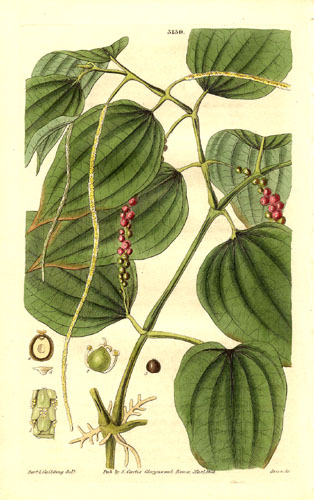
Piper nigrum. Curtis’s botanical magazine; or flower garden displayed. London, 1832, volume 59 (plate 3139). Hand-coloured engraving by Lansdown Guilding.
Ripe for the picking
Black and white, and these days, green, dried peppercorns come from the same creeping vine, piper nigrum, native to India but grown throughout south east Asia, and even Australia. The pepper berries cluster around long tendrils, looking like densely beaded drop earrings – turning from vibrant green to a deep ruby pink if left on the vine long enough. The colours can be preserved if the berries are pickled in brine, but if exposed to air they oxidise, blackening as they dry out. Harvesting and processing techniques have developed over time to achieve optimum quality dried green, black and white peppercorns for culinary use. The full processing details are well beyond the scope of this blog, but put simply, green peppercorns are under ripe berries, processed to prevent them turning black, black peppercorns are young green berries processed to allow the black outer layer or ‘pericarp’ to develop, and white peppercorns are slightly more mature berries which have the pericarp removed as they dry.
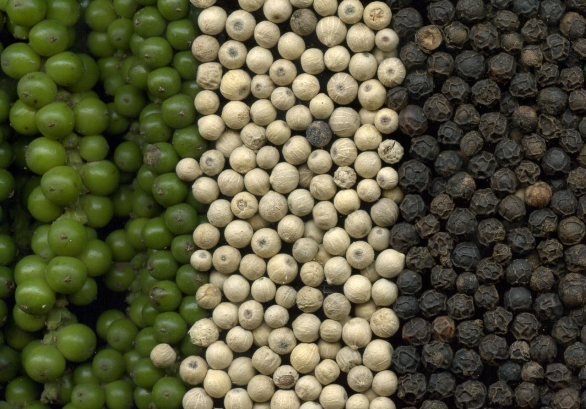
Fresh green, dried white and black peppercorns. photo by Rainer Zenz, Germany, via wikicommons
Piper-ing hot!
As the outer layer of the berries blacken and dry, natural piperine oils develop and intensify producing the lovely rich and pungent edge that many of us – I believe – are a bit addicted to. White peppercorns on the other hand, are ‘naked’ having had the outer layer, which would normally turn black, removed. It is often said that white peppercorns are hotter than black ones, which is technically true, as most of the heat comes from within the corn, although the impact is negligible in cooking. Mrs Beeton (1861) deems white pepper ‘less acrid’ than black pepper. Devoid of the oily piperine, white pepper can seem to lack complexity, and due to a soaking process they can take on a musty smell. The French found a perfect foil for this in Quatre Epice, by adding a hint of nutmeg, ginger, and clove to offset the musty notes in straight white pepper. Quatre Epice was among the many spices mentioned in the Macarthur family accounts from the 1820s. To many, ground white pepper seems terribly old fashioned, however it is very useful in cooking, particularly for pale coloured foods – think egg dishes, white sauces, cream soups and broths etc – in that it doesn’t leave visible black specks.
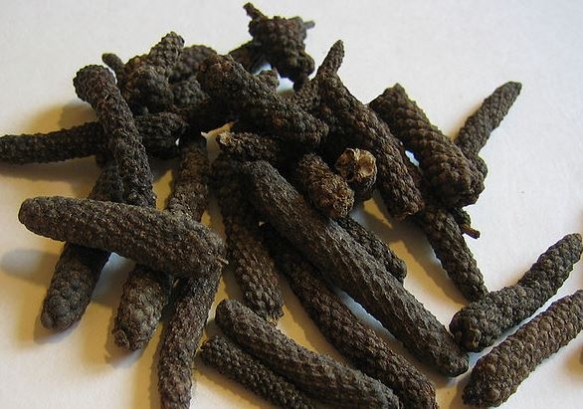
Long pepper, Piper longum (detail). Image via wiki commons.
Long pepper
I was surprised and quietly fascinated to find long pepper among the painted labels in the mid-19th century spice caddy. Originating in Indonesia, it is rarely seen these days, Indian pepper having squeezed it out of the market, but clearly it was in use in Victorian times. Long pepper features in Mrs Beeton’s Book of household management (1861) with readers being informed that ‘the Romans indulged in them to a most extravagant degree’. According to Beeton ‘the long pepper is less aromatic than the black, but its oil is more pungent’. I’ve yet to come across a recipe in Mrs Beeton’s book that actually calls for long peppers, and had always thought it was included as a curiosity until I discovered it included in the caddy (see image below). That said, the long pepper tin was one of the better preserved ones in the bottom tier of this spice caddy, and judging by the wear on the black pepper ‘Bck Pepper’ tin to its left, used less often than standard black peppercorns.
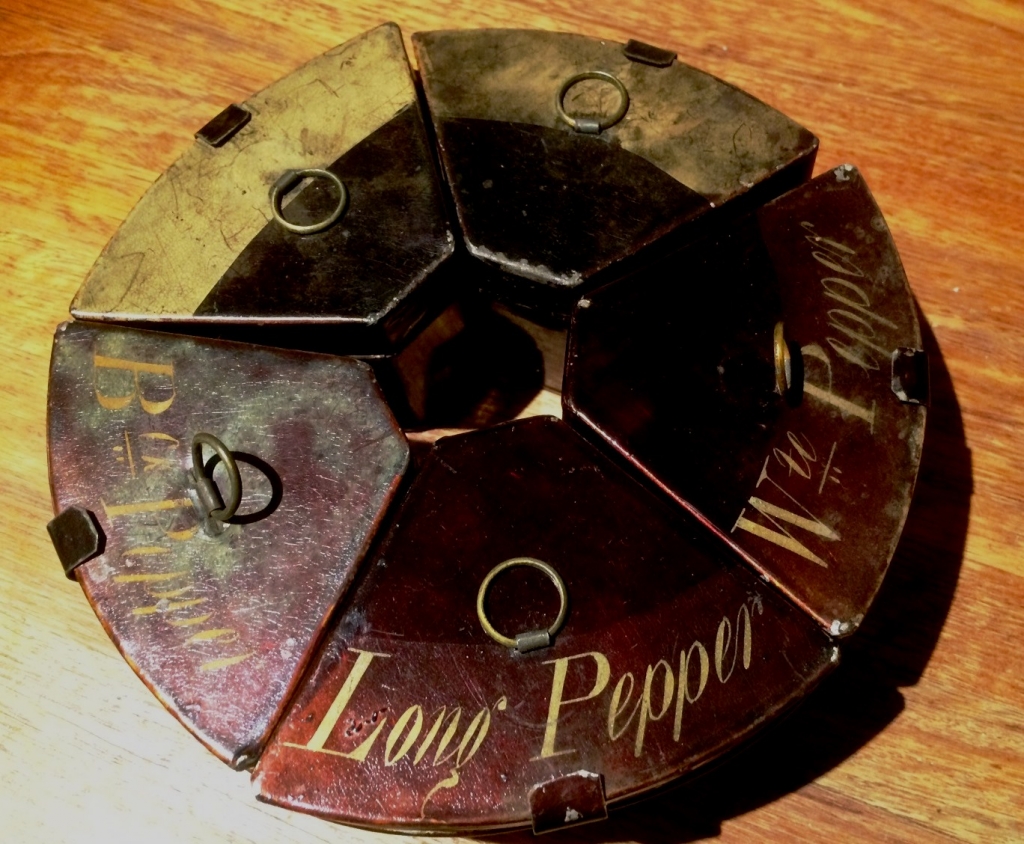
Spice containers from caddy, c1850s, which includes Long pepper. Photo © Jacqui Newling
Australian spice merchant Ian Hemphill values long pepper for its aromatic musk like notes. They make an interesting addition to curries and Moroccan tagines, not east for looking like caterpillars when cooked whole!
And Peter Piper?
Peter Piper picked a peck of pickled peppers.
A peck of pickled peppers Peter Piper picked.
If Peter Piper picked a peck of pickled peppers,
Where’s the peck of pickled peppers that Peter Piper picked? [2]
The popular ‘Peter Piper picked a peck of pickled peppers’ rhyme, first published in 1813, plays on this influential French spice merchant’s very apt name: Pierre Poivre (poivre being the French word for pepper), 1719-1796 [3]. The Anglicisation of his name plays on the piperine in pepper, as discussed above. Ironically, Pierre Poivre’s greatest contribution to global spice trade was in breaking the Dutch monopoly on Indonesian cloves and nutmeg, by successfully introducing them to the French colony of Seychelles [4].
Join us next week when we look at the other ‘Indian’ pepper – which was not from India at all…
Mrs Beeton’s Hot Spice
Ingredients
- 40g ground white pepper
- 25g ground nutmeg
- 15g ground mace
- 1/2 teaspoon ground cloves
- 3 teaspoons ground black pepper
- 3 teaspoons ground ginger
- 3 teaspoons cinnamon
- 1 teaspoon cayenne pepper or chilli powder (or substitute all or part quantity with sweet paprika )
Note
According to Mrs Beeton, Hot Spice is 'a delicious adjunct to Chops, Steaks, Gravies, etc.' Frustratingly, the recipe uses 'drachm' measures for this recipe, which, being 1/4 of a tablespoon, I have substituted with 5ml standard teaspoon. As with any spice blend, particularly those from past times, we cannot know the age, quality or pungency of the spices, so adjust to your liking.
Directions
| Combine all ingredients and mix well. Store in an airtight jar, allowing a few days for flavours to meld. As with most pre-ground blends, if made with good quality spices, the mixture will keep for approximately 18 months before losing its flavour. | |
[1] Herbie’s Spices gives more details on the production of each style of pepper
[2] I. Opie and P. Opie, The Oxford Dictionary of Nursery Rhymes (Oxford University Press, 1951, 2nd edn., 1997), p. 347.
[3] H. Carpenter and M. Prichard, The Oxford Companion to Children’s Literature (Oxford University Press, 1984), p. 408.
[4] Denis Piat. Mauritius on the Spice Route, 1598-1810. 2010.
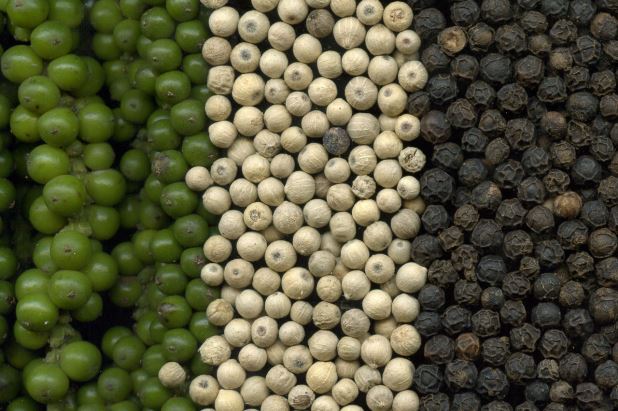
 Print recipe
Print recipe
